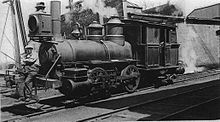South Manchester Railroad
| South Manchester Railroad | |
|---|---|
|
South Manchester Railroad on the corner of
Hartford Road and Elm Street by Cheney Hall | |
|
Right of way card, November 1932
| |
| Route length: | 5.232 km |
| Gauge : | 1435 mm ( standard gauge ) |
The South Manchester Railroad (also known as the Cheney Railroad or Cheney's Goat ) was the operating company for a short railway line in Manchester , Connecticut . It was in operation from 1869 until the 1980s.
history
The railroad company was founded on May 30, 1866, and their rail line was completed three years later by the Cheney brothers, who were then known for their success in the silk industry. There was a 3.109 km long line and 2.123 km long sidings and sidings , according to another source the line was 3.6 km long. It was the only railroad in the United States at the time that was owned by a family, not a company.
It was used to transport silk products from the Manchester silk mill and weaving mill to the company's other buildings in Hartford , Connecticut. Some workers also used them to drive to work for a small fee, but most lived in houses on the premises.
In 1914, an innovative device for automatic collision avoidance was successfully tested after President Mollen advertised a prize for developing one. To do this, the two rails of the track were wired and a battery-powered system was installed on the locomotive , which closed the main valve and applied the air brakes if the axles of another rail vehicle created a short circuit between the rails.
The rail company didn't just offer its services to Cheney employees. It was also used by students traveling from the south end to Hartford Public High School before Manchester High School was built in 1904. Theater guests took it to Cheney Hall and businesspeople to the silk shows held there. On Sundays, the train brought churchgoers to the Catholic Church at the north end and the timetable for the return journey was tailored to the time the priest needed for his mass. At special events, up to 3500 passengers used the train per day and paid 10 cents per trip. The railway also transported coal to the paper mills at the south end and agricultural products from south to north.
During the Great Depression in the 1930s, the Cheney brothers began selling much of their fixed assets . The railroad was part of this liquidation .
Initially there were unrestricted level crossings on Center Street and Hilliard Street. Wooden trestle bridges were later built over these roads due to local residents' safety concerns . The level crossing on Woodland Street remained at street level. The last passenger transport took place in 1933, but freight traffic continued until the 1980s.
Accidents
Two fatal accidents occurred with drunk people. The first victim was hit by a moving train at the Middle Turnpike level crossing. He was only noticed on the way back and died shortly afterwards at the scene of the accident. His half-liter bottle of schnapps was still unbroken on the platform. The other fatal accident happened on the embankment at Center Springs Pond.
Another man who was hit by the train and injured in the winter was brought home on a sledge. When Traffic Superintendent Richard O. Cheney visited him that day, the injured man apologized for getting in the way of the train. After his recovery, he is said not to have touched a drop of alcohol.
railway station
The station was built in 1879 for passenger and freight traffic . It was on the corner of Park Street and Elm Terrace.
Locomotives
A type B'2 (0-4-4) steam locomotive, named Mt. Nebo , was delivered by Baldwin Locomotive Works in Philadelphia , Pennsylvania in 1879 . It was designed and patented by Matthias Nace Forney for freight and passenger transport.
present
In 2005, one mile of the railway line was acquired by the Manchester Land Conservation Trust . The route is used as a footpath called the Cheney Rail Trail. Part of the route still exists and is used by rail vehicles.
Web links
Individual evidence
- ^ South Manchester Railroad . Retrieved June 17, 2016.
- ↑ 1896. 44th Annual report of the Railroad Commissioners of the State of Connecticut. Pp. 354 ff. Press of the Carr, Lockwood & Brainward Company, 1896, Hartford, Connecticut.
- ^ Railroad test in Manchester . Reprinted from a special edition of the Courant, The Hartford Courant , November 24, 1914, page 11. Retrieved June 18, 2016.
- ^ A b Susan Barlow: Connecting Manchester.
- ↑ a b c d "Goat" Makes Last Journey on Rails. Famous Old Passenger Train Goes Out of Commission After 64 Years of Linking Ends of Town; Miss Cheney a Rider on First and Last Trips. Published in the Manchester Evening Herald, Manchester, Conn. January 27, 1933. Reprinted June 18, 2016.
- ↑ Patrick Skahill: The Cheney Brothers' Rise in the Silk Industry . Retrieved June 17, 2016.
- ^ Susan Barlow: Connecting Manchester.
- ^ Cheney Brothers Historic District . Retrieved June 17, 2016.
- ↑ Doug MacGillvary Collection: Undated photo of Engine # 2. Manchester Historical Society.
- ^ Sarah L. Hamby: Cheney Railroad hike takes in local history . April 29, 2015. Retrieved June 17, 2016.
- ^ Joseph T. O'Leary: Manchester rail trail expansion to be discussed April 5 . March 28, 2016. Retrieved June 17, 2016.
Coordinates: 41 ° 47 ′ 38 " N , 72 ° 31 ′ 29" W.




